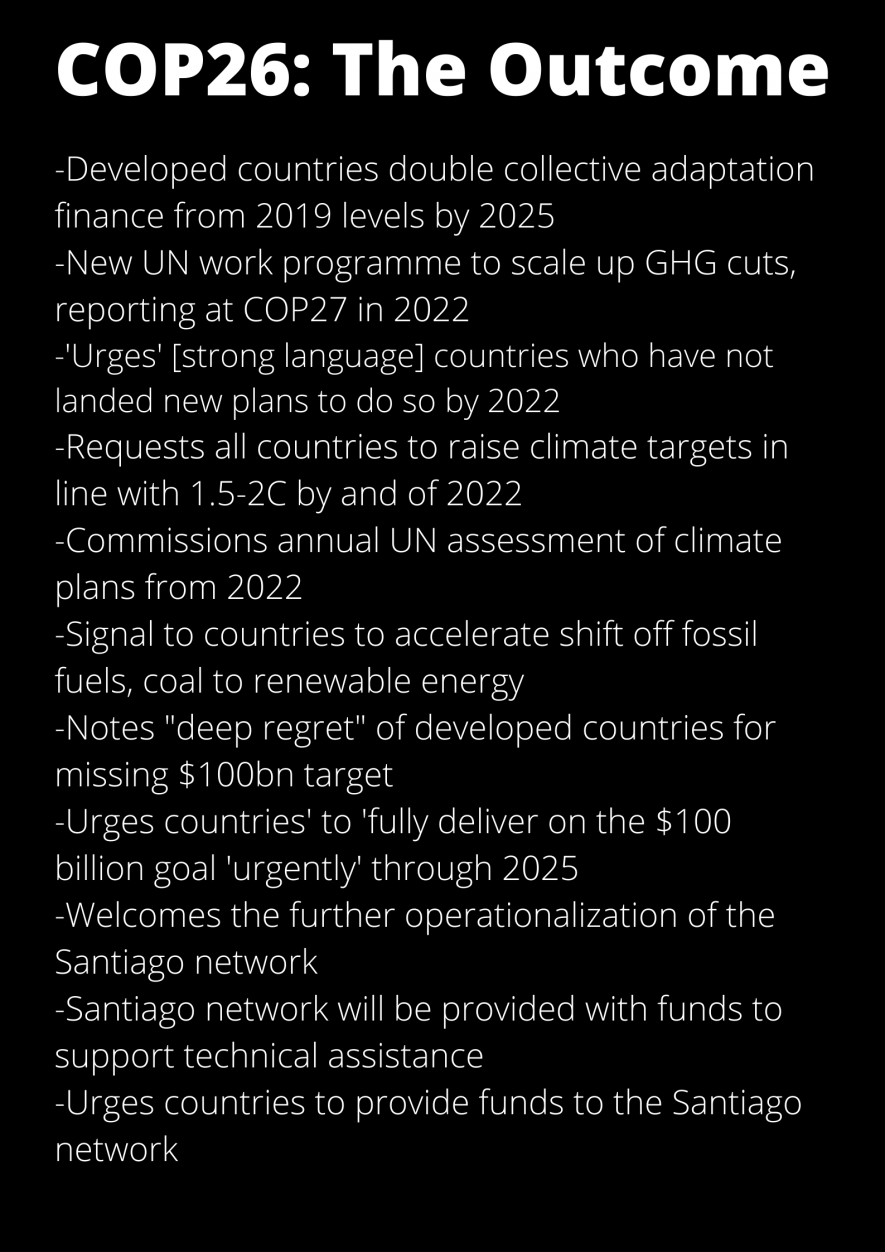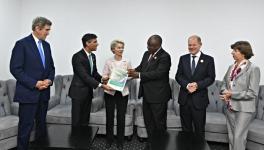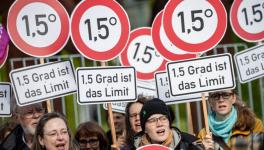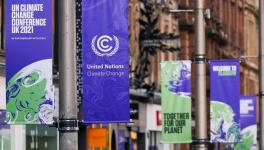A Lot is Left to be Desired in COP26
Image Courtesy: The Independent
The COP26 talks in Glasgow are over and the gap to 1.5 degree temperature has narrowed. The summit has also put in place processes for the gap to continue to narrow, and narrow faster in future.
At the same time, the European Union and the United States failed to deliver the promised $100 billion or nail down to $600 billion in climate finance during 2021-25. The developed countries have slipped back to a commitment of $100 billion a year, now in place since 2009 and as yet undelivered, but remains urgent and central to ambitious climate action.
The EU and the US blocked the establishment of even a modest fund to help vulnerable communities around the world with the massive loss and damage they are experiencing at the hands of the climate crisis. As with COVID, those with the least resources have been left to fend for themselves.
However, there’s a lot more to do to save the planet.
Laurence Tubiana, CEO - European Climate Foundation said, "Paris agreement is working. Despite the COVID-19 crisis, we have accelerated action, the COP has responded to the IPCC’s call to close the gap towards 1.5, and coal is in the text. But there is a lot more to do. The commitments and claims of the first week on finance, forests, end of public finance for fossil fuel, methane and cars must now be translated into real policy and incorporated in the new NDCs that has to be delivered by 2022. And oil and gas production still to be addressed."
"Greenwashing is the new climate denial, and we have seen too much at play in this COP. We must strengthen accountability mechanisms for net-zero going forward. We see through the discussions in Glasgow that the international finance system is not fit for the challenge and is unable to respond to the call of Mia Mottley, PM of Barbados. It needs to be fixed by world leaders now.”
“And we must address the impacts of the climate crisis on the most vulnerable. This COP has failed to provide immediate assistance for people suffering now. I welcome the doubling of adaptation finance as climate impacts are every year stronger, loss and damage must be at the top of the agenda for COP 27," she added.
The first ever mention of coal “phase down” in an international climate agreement is an important indication of the energy transformation underway. India, with its renewable energy expansion is well placed to deliver on the scale of change needed.
Despite the watering down from “phase-out” to “phase down” on coal, the cause of the climate crisis has, for the first time since the Kyoto Protocol, been called out by the 198 signatories of the Paris Agreement.
The closure of the Paris rules on carbon markets is a move forward, but loopholes still need to be added. COP 26 is real progress, but much more is still to be done.
This COP was about keeping 1.5 degrees alive. It has, to an extent, reflected the findings of the IPCC SR1.5 and IEA (International Energy Agency) net zero report, mandating an acceleration in action and new plans by 2022 in the context of the voluntary, non-binding UN regime.
All major emitters will be compelled to return in 12 months and explain at the UN how their economy-wide policies and plans are aligned to the Paris temperature goals.
While the unprecedented fossil fuels phase out pledge was weakened by a last-minute deal between China (the world's largest fossil fuel consumer), the US (the world’s largest fossil-fuel producer), the EU and India, it is still there. The change in language was condemned by small island states, Switzerland, Mexico and - ironically - the EU, which decided to support the shift despite slamming it as a "bad economic choice."
But despite progress on future emissions reductions, COP26 failed those most impacted by the climate crisis now. The EU and the US refused to create a fund that the poorest countries could draw on for crisis response - outraging small islands and many climate vulnerable nations.
As with the COVID pandemic, global solidarity to save lives has not been on display in Glasgow.
The test of COP26 will be delivery: the next 18 months are crucial in determining whether countries take action aligned to 1.5C - that means cutting emissions by 45% by 2030.
Where progress was made
Closing the Paris rulebook means that by 2024 all countries will have to report detailed data on emissions forming the baseline from which future reductions can be assessed.
Agreement on new carbon market rules closes down some of the outrageous loopholes that had been considered and creates a structured trading regime between countries, but language isn’t clear enough to stop companies gaming the system.
Agreement on 2025 as the date by when developed countries need to double their collective funds for adaptation, based on 2019 pledges. This won’t provide the necessary billions for adaptation finance that poorer countries need, but is a major improvement on the state of climate finance: only about a quarter of climate finance currently goes to adaptation, with the majority still being on mitigation.
Sector specific agreements on forests, coal, cars, methane and a $24billion agreement to stop overseas fossil fuel finance have the potential to make significant inroads into cutting emissions, but will require translation from national governments into policies and plans that have to be presented to COP in Egypt next year.
The banks and investors announcements in week one were large in numbers but devoid of substance. But the major banks have now committed to align their money to net zero in the 2020s and will face scrutiny on how they deliver on their green claims and shed fossil-fuel and other high-carbon assets.
In response to fears of greenwashing from corporates, a new expert group to assess corporate net zero claims announced by the UN Secretary General Antonio Guterres will have its work cut out. A key issue will be whether those plans drive emissions reductions, not a spoke in offsets.
Despite COVID and high costs preventing the participation of many civil society and activist groups, we still saw diverse groups come together at this COP all echoing a strong wave of support for climate action.
On Saturday November 6, over 100,000 people took to the streets in Glasgow, in one of the biggest demonstrations the city has ever seen, with indigenous groups, frontline health professionals, youth, trade unions, farm workers, and racial justice groups joining on the day.
Ulka Kelkar, Climate Programme Director, WRI Indi, said: "India will be affected by COP26 asking countries to phase out polluting coal power and withdraw inefficient fossil fuel subsidies. India will also have to join other countries to escalate emission reduction actions more frequently. This will not be easy for a lower-middle income country that is trying to lift millions of people out of poverty.”
India’s battle against climate change will be led by scaling up renewable energy, which will be the foundation of our net zero future; by industry, who will fight to stay competitive in the global economy; and by states and cities, who will need to urbanize with respect for nature.”
Now that COP-26 has finalised the rules of carbon trading, India will be able to sell more than a million carbon credits from previous years, and can also create a domestic market for carbon trading.”
Developing countries wanted a clear plan for a loss and damage funding facility. This did not happen and focus will shift to Egypt next year to deliver this. African nations spend up to 10% of GDP a year on adaptation while impacts could deliver a 20% hit to GDP in poor nations by 2050 say Christian Aid.
Paris rulebook - what happened (Carbon markets - Article 6)
The text has closed some of the outrageous loopholes, but it is not tight enough to stop companies and countries from using carbon credits as an easy way to continue polluting. And vitally, the levy on some of these transactions going to help fund the poorest countries adapt to climate change was removed. Negotiators have been trying to sign this deal for years, but the one that has been agreed at COP26 is a compromise that doesn't fully pass the test of integrity.
Transparency
The new rules represent a new era in scrutiny on government climate pledges and will ensure that by 2024 everyone can assess what other countries are doing. It means a central element of the Paris Agreement will be up and running by the mid-2020s, and we should now have more regular and more robust information on the state of GHG (greenhouse gas) emissions and progress made towards implementing NDCs. (nationally determined contributions)
Proposals that some Parties would not all use the same tables and formats for reporting are no longer included in the text. The text includes references to support for developing country Parties, and maintains the deadline for the submission of the first biennial transparency reports under the Paris Agreement by 2024.
Manjeev Puri, Distinguished Fellow, TERI said: “There is nothing much. There is no real commitment on part of developed countries to move ahead with serious & urgent domestic action let alone in terms of global collaboration and truly significant climate finance for tackling climate change.”
Timelines
Agreed rules mean all countries should deliver climate plans to the UN on five-year cycles, although analysts point to the use of the word 'encouraged' to use a common time frame for NDCs starting 2025 (with countries submitting 2035 NDCs in 2025, 2040 NDCs in 2030, etc). This "encouraged" language is weaker than before.
What else was agreed
British Prime Minister Boris Johnson set out as a measure for success for this COP action on coal, cars, cash and trees. There was a tsunami of deals delivered during COP, but the good have to be separated from the bad and the ugly: find an assessment of all the main deals here.
According to Climate Action Tracker, methane, coal, forests and transport deals contain additional action which would close the emissions gap to a 1.5C path by 9% or 2.2 GtCO2e.
Aarti Khosla, Director, Climate Trends said, “The COP26 has definitely narrowed the gap for 1.5 and the processes which can be taken for future action. But the failure of the US and EU to deliver on the promised $100 billion in climate finance remains urgent and central to any ambitious climate action. “
“Blocking the establishment of even a modest fund to help vulnerable communities around the world with the massive loss and damage they are experiencing at the hands of the climate crisis is a serious blow. As with COVID, those with the least resources have been left to fend for themselves. However, the first ever mention of coal phasedown in an international climate agreement is an important indication of the energy transformation underway and a clear signal to markets and industry. COP26 is real progress but much more is still to be done,” she added.
The deals come into a transition which is sufficiently underway that there is no longer a meaningful case for investing in new carbon-heavy infrastructure, according to think tank Systemiq in a report released during COP. All major sectors are capable of developing cost-competitive green solutions by 2030, meaning the business case for any high-carbon infrastructure built today should be seriously questioned.
For sectoral action to help close the gap to the 1.5 Celsius threshold in time, governments will need to deploy supportive policies and the signatories to these deals will need to be held to account to come good on their promises.
COP26: The Outcome

The writer is a Chandigarh based freelance journalist who tweets @seema_env. The views are personal.
Get the latest reports & analysis with people's perspective on Protests, movements & deep analytical videos, discussions of the current affairs in your Telegram app. Subscribe to NewsClick's Telegram channel & get Real-Time updates on stories, as they get published on our website.
























